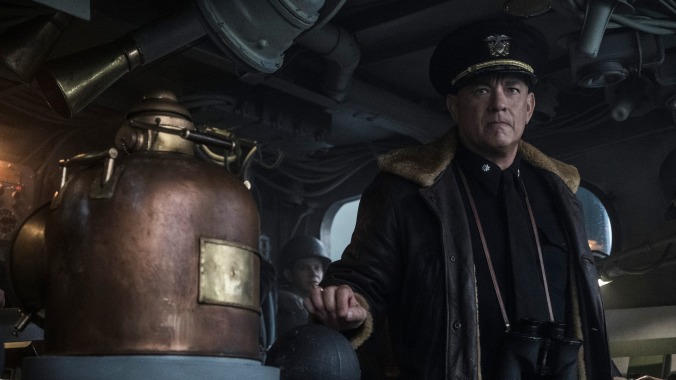Tom Hanks anchors the compelling nautical thriller Greyhound

It’s World War II. Captain Ernest Krause, the kind of humble hero who says grace before drinking coffee, has been put in command of the long-range destroyer USS Greyhound as it escorts a convoy of Allied supply ships across the Atlantic. German U-boats are hunting in the cold, choppy waters, appearing as sinister pips on the radar or creepy screw noises on the hydrophone. On the bridge of the USS Greyhound, this occasions clangs, whistles, and a naval staccato of “starboards,” “bearings,” “full rudders,” and “aye aye, sirs,” to which Krause contributes occasional scriptural quotation. To certain ears, this is pure music: “Boatswain, sound general quarters,” “Right handsomely to 096,” and so on.
The truth is that a movie like Greyhound isn’t hard to understand: There are big ships and there are submarines and inside both are men. We take it for granted that Captain Krause is an individual of good moral fiber, because he’s played by Tom Hanks, who also wrote the screenplay, adapting the C.S. Forester novel The Good Shepherd. If there were any grandiose intentions on Hanks’ part, they aren’t evident in the film’s trim running time (barely 80 minutes without credits) or its single-minded commitment to depicting the uncertainties and logistics of naval warfare.
Under the stolid direction of Aaron Schneider, the bridge of the destroyer becomes a stage for Krause’s internal drama, accompanied by the Greek chorus of the chain of command. The characterizations are minimal, but believable. (It helps that the always engaging Stephen Graham is on hand as Krause’s executive officer.) The story is set over 48 hours, beginning with the first appearance of a U-boat. At each turn, Krause is faced with tactical thought exercises without easy answers: Should he try to rescue the crew of a burning supply ship or speed off to protect another that’s undefended? Should he risk shutting down a malfunctioning radar for repairs? Should he call for support, knowing that the Germans are probably listening?
The movie’s ubiquitous visual effects aren’t as convincing as its depiction of the crew, but its competently defined sense of scale keeps the ships and submarines from looking like glorified digital bath toys. The point of view is often limited to the bridge of the USS Greyhound; our only contact with other warships comes by radio, and we rarely see the vessels of the convoy from less than a few miles away. As it happens, this verisimilitude is a good way to create suspense. If Greyhound isn’t a stylistic achievement on the level of Dunkirk, it at least manages to make something gripping out of staggering numbers and distances involved in combat at sea—even if its climactic stretch sometimes struggles with visual monotony.
Obviously, it’s hard to overlook the religious allegory: the flock, the wolves, the tests and tribulations. All of this comes from the source material, though Forester (who is better known for his Horatio Hornblower novels) is said to have been an atheist. One might go so far as to say that it’s really a matter of character psychology, and that the theme, familiar from other works of serious-minded military fiction, is one of the imperfect mapping of moral systems across the necessities of warfare. Perhaps some of it has been lost in adaptation. But apart from his disapproval of profanity (the poetry of sailors), Krause is more relatable than the egomaniacs and hard-asses that command most Navy vessels in Hollywood movies.
In the realistic pace of the film, there’s no room for speeches, rah-rah, or verbal exposition. But that doesn’t mean that it doesn’t have reflective pauses (mostly on the subject of death and cruel irony) or those moments of genre poetics that happen organically in war films. But at its best, Greyhound is about the non-metaphors of war: torpedoes, the terror of friendly fire, the complexities of steering a destroyer, messages, orders. Throughout these are seconds of hesitation in which we see something human.